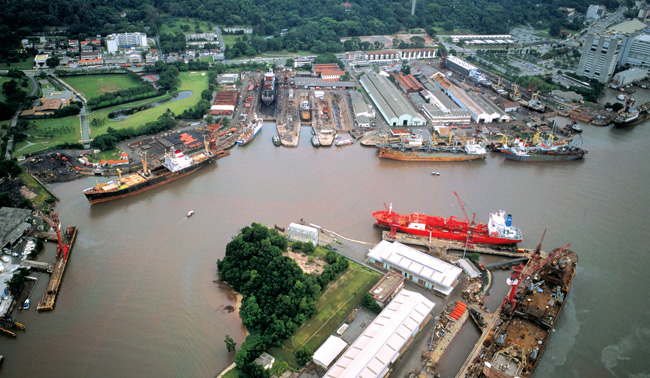Heritage
Keppel Offshore & Marine (Keppel O&M) was incorporated in 2002 through the integration of three well-established offshore and marine companies with a combined heritage of over 300 years - Keppel Shipyard, Keppel FELS and Keppel Singmarine.
The Company's rich tradition dates back to the construction of Singapore's first shiprepair drydock at Keppel Harbour in 1859. Keppel Shipyard was formerly incorporated in 1968 to manage the dockyard assets, as part of the Government's efforts to privatise Singapore's shiprepair industry.

The 1970s: Charting new waters
This was a definitive growth period in Keppel's history, marked by a deliberate foray into the shiprepair, shipbuilding and offshore businesses, and the onset of the company's expansion beyond Singapore's shores.
In the early 70s, Keppel Shipyard acquired stakes in Keppel FELS' predecessor company, Far East Shipbuilding Industries Limited (FESL). FESL was a family-owned offshore yard, which was later renamed Far East Levingston Shipbuilding (FELS) and listed on the stock exchanges of Singapore and Malaysia.
Throughout this decade, FELS added several significant deliveries to its growing newbuild track record, including its first jackup, semisubmersible and drillship units.
In 1975, Keppel Shipyard launched into its pioneering overseas venture, and set up the Keppel Philippines Shipyard. A year later, it acquired the Singmarine yard, a medium-sized shipbuilder and repairer in Singapore.
The 1980s: Staying the course
In 1980, Keppel Shipyard was listed on the Singapore Stock Exchange. But just as the company's growth was gathering momentum, the global offshore and marine industry plunged into a 20-year gloom in the mid-80s, Singapore was also hit by a major recession.
Keppel's hallmark Can-Do! spirit was forged as it steered through the harsh economic and business terrain, making prudent moves to stay on course and prepare for the upturn.
The Company proved its versatility and resolve to deliver on time and on budget, with several ground-breaking projects. These included its first Floating Production Storage Offloading vessel conversion, and the construction of its first floating accommodation unit and tension leg wellhead platform.
The Company also grew its presence in the Philippines with the acquisition of the Cebu Shipyard.
Then in 1986, Keppel Shipyard became Keppel Corporation, but had its name retained as a major operating division.
The 1990s: Going Near Market, Near Customer
Keppel's overseas forays intensified with increasing globalisation. It made bold steps to acquire new yards and competencies, as well as entered into strategic partnerships to further its Near Market, Near Customer strategy.
The Company acquired the AMFELS shipyard in Brownsville, Texas, set up the Caspian Shipyard Company in Baku (Azerbaijan), as well as planted its flag in the United Arab Emirates, Norway and Bulgaria. Keppel also consolidated its presence in the Philippines and inaugurated a third yard in Subic City.
By 1997, FELS was renamed Keppel FELS, and launched into rig design with the acquisition of rights to the Freide & Goldman MOD V and MOD VI jackup models. The Offshore Technology Development (OTD) unit specialising in jackup rigs and related critical equipment was also formed to support the business.
Meanwhile, Singmarine was renamed Keppel Marine Industries, and Keppel Shipyard was merged with Hitachi Zosen to form Keppel Hitachi Zosen.
Early 2000: Becoming the preferred solutions partner
At the turn of the new millennium, Keppel continued to fortify its global presence and technology capabilities, as it streamlined its operations in anticipation of an improving market.
In 2000, Keppel FELS entered into Brazil through a joint venture yard with the Pem Setal Group, as well as built its first KFELS B Class jackup rig, the Chiles Discovery (later renamed ENSCO 104). It also acquired a majority stake in the Singapore Petroleum Company, which was later divested.
2002 was a significant turning point in Keppel's history - Keppel O&M was established in a strategic move to restructure and integrate the Group's various offshore and marine businesses under one banner.
As a unified and formidable Group, Keppel O&M pressed forward with its Near Market, Near Customer strategy. In the same period, Keppel O&M USA and the Houston Centre were established in Houston, Texas.
Keppel O&M also acquired the Keppel Verolme yard in the Netherlands, as well as set up yard facilities in Kazakhstan, Nantong (China) and Bintan (Indonesia). The Group also entered into a milestone partnership with Qatar's gas transport company, Nakilat, to develop a world class shipyard in Qatar, and grew its presence in Azerbaijan and Brazil with new facilities.
On the technology front, Keppel O&M formed the Deepwater Technology Group (DTG) to focus on semisubmersibles and floating structures, and the Marine Technology Development (MTD) unit to specialise in offshore support vessels and tugboats. Then in 2007, the Keppel O&M Technology Centre was established to augment the three design and engineering arms, including OTD, in the field of R&D.
Today
Keppel O&M is one of the world's largest offshore and marine groups with a strong network of 20 yards worldwide. Leveraging its business foresight, technology leadership and proven competencies built up over the decades, the Group is set to be the provider of choice and partner for solutions in the global oil and gas industry.



